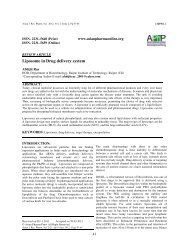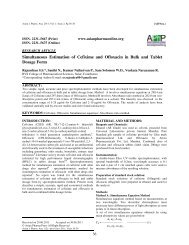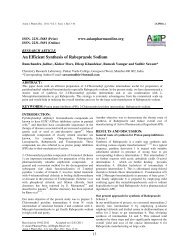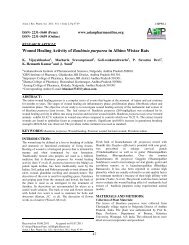Download PDF - asian pharma press
Download PDF - asian pharma press
Download PDF - asian pharma press
Create successful ePaper yourself
Turn your PDF publications into a flip-book with our unique Google optimized e-Paper software.
Asian J. Res. Pharm. Sci. 2013; Vol. 3: Issue 1, Pg 42-44<br />
Palmitic acid<br />
[AJPSci.]<br />
Anti-inflammatory, Analgesic and Antipyretic activity<br />
Aqueous extract of Coccinia indica (leaves) produced<br />
marked analgesic and antipyretic activity at 300mg/kg dose<br />
when compared with standard drugs (Morphine and<br />
Paracetamol). The extract also showed significant antiinflammatory<br />
activity. 5 (Junaid Niazi et al )<br />
Antimicrobial activity<br />
Petroleum ether and methanolic extract of Coccinia indica<br />
showed the highest antimicrobial activity against grampositive<br />
organisms. 6<br />
Oleic Acid<br />
Antibacterial Activity<br />
Ethanol and aqueous extracts of Coccinia indica showed<br />
promising antibacterial activity against the Enterobacter<br />
aerogenes, Pseudomonas aeruginosa, Staphylococcus<br />
epidermidis, Bacillus subtilis and Salmonella typhimurium<br />
by agar well diffusion method and broth dilution method. 7<br />
Linoleic Acid<br />
Antihyperglycemic activity<br />
Chronic administration of Coccinia Indica (fruits) extract at<br />
dose of 200mg/kg for 14 days reduces the blood glucose<br />
level of the diabetes induced animals as compared to<br />
diabetic control group. 8<br />
Hepatoproetcective activity<br />
Coccinia indica leave extract at dose 400 mg/kg body<br />
weight showed potent hepatoproetcective activity in albino<br />
rats. 9<br />
Riboflavin<br />
TRADITIONAL USES:<br />
The fruit of Coccinia indica is useful in biliousness and<br />
diseases of blood. The green fruit is chewed to cure sores<br />
on the tongue. The bark of root is used as cathartic. The<br />
leaves are applied externally in eruptions of the skin. The<br />
leaves of this plant are boiled in gingelly oil and applied<br />
externally in ringworm, psoriasis and itch. The leaves are<br />
also used as expectorant and antispasmodic. The oil is used<br />
in application to ulcers and as an injection into chronic<br />
sinuses. The plant is also used in the treatment of<br />
gonorrhea.<br />
Taraxerol<br />
PHARMACOLOGICAL PROFILE:<br />
Anthelmintic Activity<br />
Methanol extract of Coccinia indica fruits in the<br />
concentration of 50 mg/ml showed potent anthelmintic<br />
activity against Pheretima posthuma. 3<br />
Antioxidant activity<br />
Oral administration of ethanolic extract of Coccinia indica<br />
(leaf) extract (CLEt) (200 mg/kg body weight) for 45 days<br />
resulted in a significant reduction in thiobarbituric acid<br />
reactive substances and hydroperoxides in rats. 4<br />
Table 1 Vernacular names of Coccinia indica<br />
S.N. Names Language<br />
1 Kanduri Hindi<br />
2 Bimbu Bengal<br />
3 Galedu Gujerati<br />
4 Bimbi Marathi<br />
5 Kundru Punjab<br />
6 Bimbaka Sanskrit<br />
7 Kovai Tamil<br />
8 Kundaru Urdu<br />
Table 2 Scientific Classification<br />
Kingdom Plantae<br />
Division Magnoliophyta<br />
Class<br />
Magnoliophyta<br />
Order Cucurbitales<br />
Family Cucurbitaceae<br />
Genus Coccinia<br />
Species Indica<br />
43
















